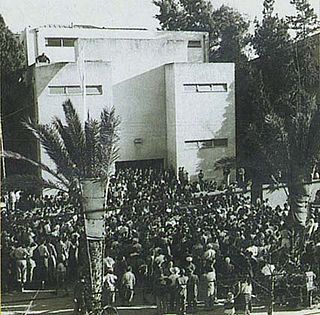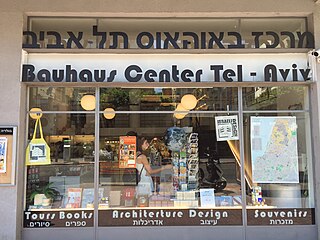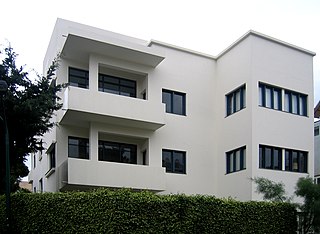
The Staatliches Bauhaus, commonly known as the Bauhaus, was a German art school operational from 1919 to 1933 that combined crafts and the fine arts, and was famous for the approach to design that it publicized and taught.

Tel Aviv-Yafo, often referred to as just Tel Aviv, is the most populous city in the Gush Dan metropolitan area of Israel. Located on the Israeli Mediterranean coastline and with a population of 451,523, it is the economic and technological center of the country. If East Jerusalem is considered part of Israel, Tel Aviv is the country's second most populous city after Jerusalem; if not, Tel Aviv is the most populous city before West Jerusalem.

Walter Adolph Georg Gropius was a German architect and founder of the Bauhaus School, who, along with Alvar Aalto, Ludwig Mies van der Rohe, Le Corbusier and Frank Lloyd Wright, is widely regarded as one of the pioneering masters of modernist architecture. He is a founder of Bauhaus in Weimar (1919). Gropius was also a leading architect of the International Style.

The International Style is a major architectural style that was developed in the 1920s and 1930s and was closely related to modernism and modern architecture. It was first defined by Museum of Modern Art curators Henry-Russell Hitchcock and Philip Johnson in 1932, based on works of architecture from the 1920s.

Modern architecture, or modernist architecture, was based upon new and innovative technologies of construction, particularly the use of glass, steel and reinforced concrete; the idea that form should follow function (functionalism); an embrace of minimalism; and a rejection of ornament. It emerged in the first half of the 20th century and became dominant after World War II until the 1980s, when it was gradually replaced as the principal style for institutional and corporate buildings by postmodern architecture.
The year 1933 in architecture involved some significant architectural events and new buildings.

Günther Förg was a German painter, graphic designer, sculptor and photographer. His abstract style was influenced by American abstract painting.

The White City refers to a collection of over 4,000 buildings built in a unique form of the International Style in Tel Aviv from the 1930s, with a strong Bauhaus component, by Jewish architects from Germany and other Central and East European countries with German Cultural influences, who immigrated to the British Mandate of Palestine after the rise to power of the Nazis in Germany. Tel Aviv has the largest number of buildings in the Bauhaus/International Style of any city in the world. Preservation, documentation, and exhibitions have brought attention to Tel Aviv's collection of 1930s architecture. In 2003, the United Nations Educational, Scientific and Cultural Organization (UNESCO) proclaimed Tel Aviv's White City a World Cultural Heritage site, as "an outstanding example of new town planning and architecture in the early 20th century." The citation recognized the unique adaptation of modern international architectural trends to the cultural, climatic, and local traditions of the city. Bauhaus Center Tel Aviv organizes regular architectural tours of the city.

Rothschild Boulevard is one of the principal streets in the center of Tel Aviv, Israel, beginning in Neve Tzedek at its southwestern edge and running north to Habima Theatre. It is one of the most expensive streets in the city, being one of the city's main tourist attractions. It features a wide, tree-lined central strip with pedestrian and bike lanes.

The architecture of Israel has been influenced by the different styles of architecture brought in by those who have occupied the country over time, sometimes modified to suit the local climate and landscape. Fortified Crusader castles, Islamic madrassas, Byzantine churches, Templer houses, Arab arches and minarets, Russian Orthodox onion domes, Bauhaus-style modernist buildings, sculptural concrete Brutalist architecture, and soaring glass-sided skyscrapers all are part of the architecture of Israel.

Arieh Sharon was an Israeli architect and winner of the Israel Prize for Architecture in 1962. Sharon was a critical contributor to the early architecture in Israel and the leader of the first master plan of the young state, reporting to then Prime Minister, David Ben-Gurion. Sharon studied at the Bauhaus in Dessau under Walter Gropius and Hannes Meyer and on his return to Israel in 1931, started building in the International Style, better known locally as the Bauhaus style of Tel Aviv. Sharon built private houses, cinemas and in 1937 his first hospital, a field in which he specialized in his later career, planning and constructing many of the country's largest medical centers.

Carl Rubin was an Israeli architect known for his work in the international style. He designed many of the iconic buildings in this style in Tel Aviv.

Bauhaus Center Tel Aviv is an organization dedicated to creating a platform for Bauhaus architecture and design in the city of Tel Aviv, Israel. Buildings designed in the International Style, commonly known as Bauhaus, comprise most of the center of Tel Aviv known as The White City. The vision behind the Center is to raise awareness of the Bauhaus heritage and be part of the cultural and artistic development in Tel Aviv.
Nitza Metzger-Szmuk is an Israeli architect, and Emet Prize laureate in architecture for her work on documentation and preservation of Tel Aviv's White City. She also received the Rokach Prize in 2001.
Dov Karmi was a renowned Israeli architect of the pre-statehood era.
The M.T. Abraham Foundation is a non-profit art institution, which is part of the M.T. Abraham Group S.A. Its headquarters are in Paris, France, and its collections are stored in Geneva, Switzerland. It was founded by the descendants of Mansur Tamir Abraham after his death in 1999. Its stated intent is promoting public appreciation for Russian and European Modernism, Impressionism, and Modern Art by collecting pieces that can be loaned "for the sole purpose of display and study by public institutions."

Amir G. Kabiri is an Israeli businessman, Investor, Industrial, art collector, Chairman of the M.T. Abraham Group S.A., owner of Hapoel Tel-Aviv F.C., and best known as the owner of The Art Newspaper Israel, President of the M.T. Abraham Foundation and the Hermitage Museum Foundation Israel.

Elsa Mandelstamm Gidoni was a German-American architect and interior designer.

Ben-Ami Shulman was an Israeli architect who was posthumously recognized as one of the significant 1930s architects of the modernist White City of Tel Aviv. The White City, which features the largest collection of international style architecture in the world, was designated a UNESCO World Heritage Site in 2003.

The Bauhaus Foundation in Tel Aviv, Israel, has a private museum on the ground floor of a building built in the International Style in 1934, located on 21 Bialik Street. It is owned by American billionaire, businessperson, art collector and philanthropist Ronald Lauder.















